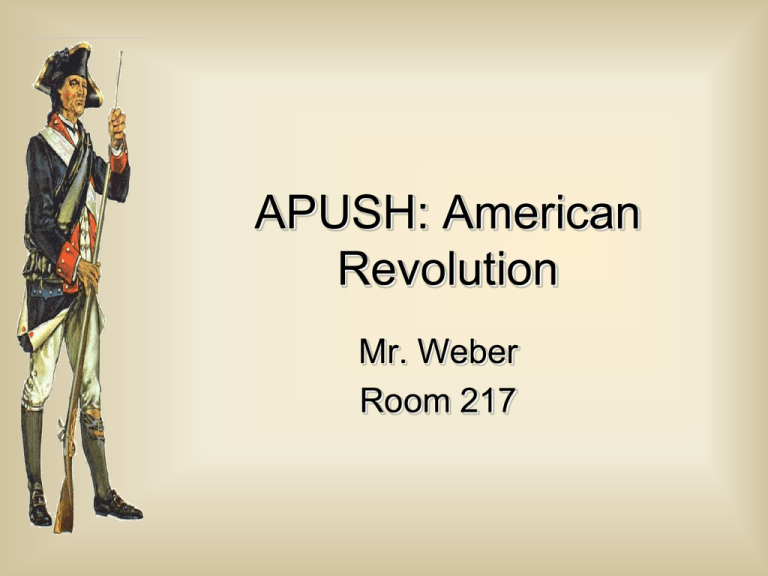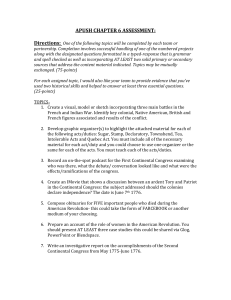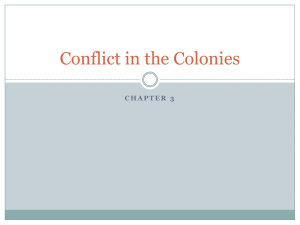AP12 American Revolution
advertisement

APUSH: American Revolution Mr. Weber Room 217 Agenda • Activator, agenda, and objective (10 minutes) • Ch. 4 reading test (15 minutes) • American Revolution lecture (45 minutes) • Independent Reading (30-45 minutes) • Exit ticket and homework (5 minutes) Objective • AP Topic #4: – The American Revolutionary Era, 1754–1789 – The French and Indian War – The Imperial Crisis and resistance to Britain – The War for Independence – State constitutions and the Articles of Confederation – The federal Constitution Unit 2: Revolutionary America and the Early Republic 1763-1840 • Essential Questions: • In what ways were the ideals of the Declaration, Revolution, and Constitution contradicted by the realities of life in early America (especially for African Americans, women, poor people, and immigrants)? • What unified and what divided the colonists at the time of the Revolution? • What were the ramifications of using slaves in the British and Continental armies. Why did the British authorize the use of slaves, why did the American colonists, and what were the benefits for the slaves? • Why did the colonists increasingly believe that British rule threatened their liberty? • How did Common Sense and the Declaration of Independence reflect the idea put forth by philosophers like John Locke that liberty was a natural right? Chapter 5: American Revolution Highlights • Chapter concentrates on events leading up to the war and the war itself. • Anger against colonial governors symbolized in mob violence against Thomas Hutchinson in Massachusetts in response to Stamp Act. • Sons of Liberty begin claiming that the British have “enslaved” the colonists. • When war broke out in 1775 independence was not necessarily the clear goal of the 1st Continental Congress. American Revolution Highlights (cont.) • Thomas Paine’s Common Sense articulates the concerns of the colonists. • Question of whether slaves should fight and on which side is explored in Lord Dunmore’s Proclamation and George Washington’s response. • Not all colonists were “revolutionaries.” Loyalists (loyal to British) like James Chalmers of Maryland form an important dissenting voice to the revolutionary discourse. The Crises Begins • Before the Seven Years War, Britain had loosely tried to regulate the colonies’ economy. • After the war London insisted that the colonists play a subordinate role to the mother country to help pay for the protection the British provided. • Members of the British Parliament had virtual representation. • The colonists argued that London could not tax them because they were not represented in Parliament. Taxing the Colonies • The Sugar Act of 1764 and the revenue act threatened the profits of colonial merchants. • The Stamp Act of 1765 was a direct tax on printed materials. • Opposition to the Stamp Act was the first great drama of the revolutionary era. • The Stamp Act Congress met in 1765 to endorse the Virginia House of Burgesses’ resolutions. Patrick Henry took leading role. Politics in the Streets • The Sons of Liberty were organized to resist the Stamp Act and enforce a boycott of British goods. • London repealed the Stamp Act but replaced it with the Declaratory Act. • Settlers also used “liberty” in regard to land disputes. • Land disputes were behind the creation of Vermont (Ethan Allen takes lead role). Road to Revolution • Townshend Act of 1767 imposed tax on imported goods. • Led to boycott and “homespun virtue.” • Boston Massacre 1770 – 5 colonists die including African American Crispus Attucks. • Tea Act, Intolerable Acts, and Quebec Act as figurative last straws for many. Coming of Independence • Continental Congress organized in Philadelphia in 1774 to resist the Intolerable Acts. • Outbreak of war at Lexington and Concord. – Battle of Bunker Hill (British victory) – Second Continental Congress (elects Washington as commander). – Early war went badly (colonists deserting, etc.) – Washington managed a surprise attack at Trenton and Princeton. – Battle of Saratoga 1777 (victory for colonists and “turning point” of the war). – French convinced to help the colonists. – American troops surround general Cornwallis at Yorktown where he surrenders in October of 1781. – Treaty of Paris signed in 1783 (John Adams, Ben Franklin, John Jay) Supplemental Notes More from the Revolution but not necessarily from your reading On the Eve of the Revolution ? Britain Americans Advantages ? ? Disadvantages ? ? Loyalist Strongholds Washington’s Headaches Only 1/3 of the colonists were in favor of a war for independence [the other third were Loyalists, and the final third were neutral]. State/colony loyalties. Congress couldn’t tax to raise money for the Continental Army. Poor training [until the arrival of Baron von Steuben. Exports & Imports: 1768-1783 Military Strategies The Americans Attrition [the Brits had a long supply line]. Guerilla tactics [fight an insurgent war you don’t have to win a battle, just wear the British down] Make an alliance with one of Britain’s enemies. The British Break the colonies in half by getting between the No. & the So. Blockade the ports to prevent the flow of goods and supplies from an ally. “Divide and Conquer” use the Loyalists. Phase I: The Northern Campaign [1775-1776] Bunker Hill (June, 1775) The British suffered over 40% casualties. Phase II: NY & PA [1777-1778] New York City in Flames (1776) Washington Crossing the Delaware Painted by Emanuel Leutze, 1851 Saratoga: “Turning Point” of the War? A modern-day re-enactment Phase III: The Southern Strategy [1780-1781] Britain’s “Southern Strategy” Britain thought that there were more Loyalists in the South. Southern resources were more valuable/worth preserving. The British win a number of small victories, but cannot pacify the countryside [similar to U. S. failures in Vietnam!] Good US General: Nathanial Greene The Battle of Yorktown (1781) Count de Rochambeau Admiral De Grasse Cornwallis’ Surrender at Yorktown: “The World Turned Upside Down!” Painted by John Trumbull, 1797 North America After the Treaty of Paris, 1783 Wholesale Price Index: 1770-1789 Federalist vs. Anti-Federalist Strongholds at the End of the War Weaknesses of the Articles of Confederation A unicameral Congress [9 of 13 votes to pass a law]. 13 out of 13 to amend. Representatives were frequently absent. Could not tax or raise armies. No executive or judicial branches. State Constitutions Republicanism. Most had strong governors with veto power. Most had bicameral legislatures. Property required for voting. Some had universal white male suffrage. Most had bills of rights. Many had a continuation of stateestablished religions while others disestablished religion. Occupational Composition of Several State Assemblies in the 1780s Indian Land Cessions: 1768-1799 Disputed Territorial Claims Between Spain & the U. S.: 1783-1796 State Claims to Western Lands Land Ordinance of 1785 Northwest Ordinance of 1787 One of the major accomplishments of the Confederation Congress! Statehood achieved in three stages: 1. Congress appointed 3 judges & a governor to govern the territory. 2. When population reached 5,000 adult male landowners elect territorial legislature. 3. When population reached 60,000 elect delegates to a state constitutional convention. The United States in 1787 American Exports, To & From Britain: 1783-1789 Annapolis Convention (1786) 12 representatives from 5 states [NY, NJ, PA, DE, VA] GOAL address barriers that limited trade and commerce between the states. Not enough states were represented to make any real progress. Sent a report to the Congress to call a meeting of all the states to meet in Philadelphia to examine areas broader than just trade and commerce. Shays’ Rebellion: 1786-7 Daniel Shays Western MA Small farmers angered by crushing debts and taxes. Shays’ Rebellion: 1786-7 Shays’ Rebellion: 1786-7 There could be no stronger evidence of the want of energy in our governments than these disorders. -- George Washington Exit ticket and homework • Your homework is to begin reading Chapter 5. • Remember at least 5 pages per day!








